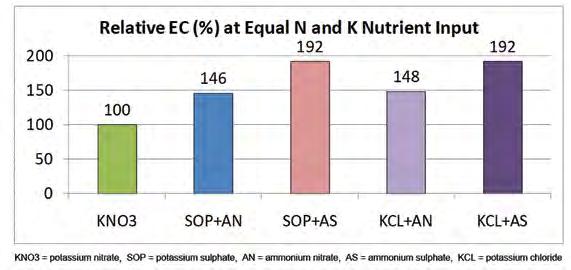
4 minute read
Plant nutrition concepts in nut crops
Although nut crops are often grouped together as a group of unrelated crops, there are certain nutrient strategies that apply to all which can be optimized by using Ultrasol K Plus** (Potassium Nitrate).
Nut trees are normally low yielding high-value crops, and good nutritional management practices are necessary to ensure optimum yield and quality. Besides important physical soil factors, such as soil compaction, soil drainage, effective rooting depth and soil temperature, important chemical aspects to consider are soil pH, salinity, fertiliser timing and placement, nitrogen form and the nutrient removal amounts (the quantity to apply).
Nut crops are mostly a group of unrelated crops. Generally, they are grouped together because the fruit type is a nut and harvesting, post-harvest processing, nutritional value and marketing are relatively similar.
To generalise with nutrient strategies for the different nut types would be an error, so it is best to focus on a few factors that would be common to most nut types.
Most nut trees are sensitive to chloride. Although chloride is an essential element in trace amounts, excess chloride, either already in the soil or in the irrigation water, or applied as KCL fertiliser to supply the tree with potassium (K), will cause a reduction in yield and quality. Toxic amounts of chloride will result in leaf scorch and will reduce photosynthetic capacity. In addition, there is a negative linear relationship between chloride uptake and reduced nitrate-nitrogen uptake. Chloride, therefore, even in sub-toxic amounts but in excess, will inhibit nitrate-nitrogen uptake affecting plant growth, resulting in reduced yield and quality.
Most nut trees are susceptible to salinity. Naturally occurring excesses of chloride are often associated with excessive sodium, the two main elemental ions causing salinity stress. Salinity stress, or salt accumulation in the root zone, will occur in drier regions and/or with insufficient irrigation water to leach out any accumulated salts. It is imperative in situations such as this to select fertilisers with the lowest salt index. Because nitrogen and potassium are both elements used in the greatest quantities by horticultural crops – including nuts – it makes perfect sense to use potassium nitrate as the fertiliser of choice to supply both these “high requirement” elements.
Salinity is not only caused by excess chloride and sodium. Excesses of calcium and magnesium, generally associated with high pH soils, will also cause salinity. In addition, any element given in abundance to the requirement by the plant also contributes to root zone salinity which will compound any natural salt salinity that there is. A good example of this might be an over-application of sulphates.
Sulphur is certainly an essential element, but it is needed in relatively small amounts. Often growers will go chloride-free (on good advice) and then apply the large K requirement as potassium sulphate. The excess sulphate (up to 10x more than what is required) contributes directly to soil salinity, affecting both yield and quality.
The figure shows the relative salt index or % electrical conductivity (% EC) compared to potassium nitrate as the standard (100%). The shown fertiliser types are adding salts in excess of what is required by the plant, contributing to the EC stress (salinity stress). At the same amount of N and K, using potassium sulphate or potassium chloride in conjunction with another N source greatly increases the root zone salinity.
Besides supplying both essential elements, potassium nitrate supplies nitrogen in the nitrate (NO3)- form. As can be seen from the chemical formula, this is a negative anion. Plants like to maintain an electrochemical balance and (NO3)- synergistically enhances the uptake of K+, Ca++ and Mg++, the positively charged cations. Therefore, it makes perfect sense to supply the high nitrogen requirement and the high potassium and relatively high calcium and magnesium requirements using nitrate nitrogen. Potassium nitrate enables producers to maximise their nitrate inputs facilitating this uptake synergy. For high pH areas, acid-enhanced potassium nitrate is available as Ultrasol K Plus Acid*** .
*All claims in this article can be substantiated with references which can be made available on request. **Reg No K5020 Act 36/1947. Registration holder Sociedad Quimica y Minera (Africa)(Pty)Ltd ***Reg No K6489 Act 36/1947. Registration holder Sociedad Quimica y Minera (Africa)(Pty)Ltd Disclaimer The information herein contained is given to the best of SQM’s knowledge and is believed to be accurate. The conditions of use and application of the suggested recommendations, are beyond SQM’s control. No warranty is made as to the accuracy of any data or statements contained herein. SQM specifically disclaims any responsibility or liability relating to the use of the recommendations and shall under no circumstances whatsoever, be liable for any special, incidental or consequential damages arising from such use.















